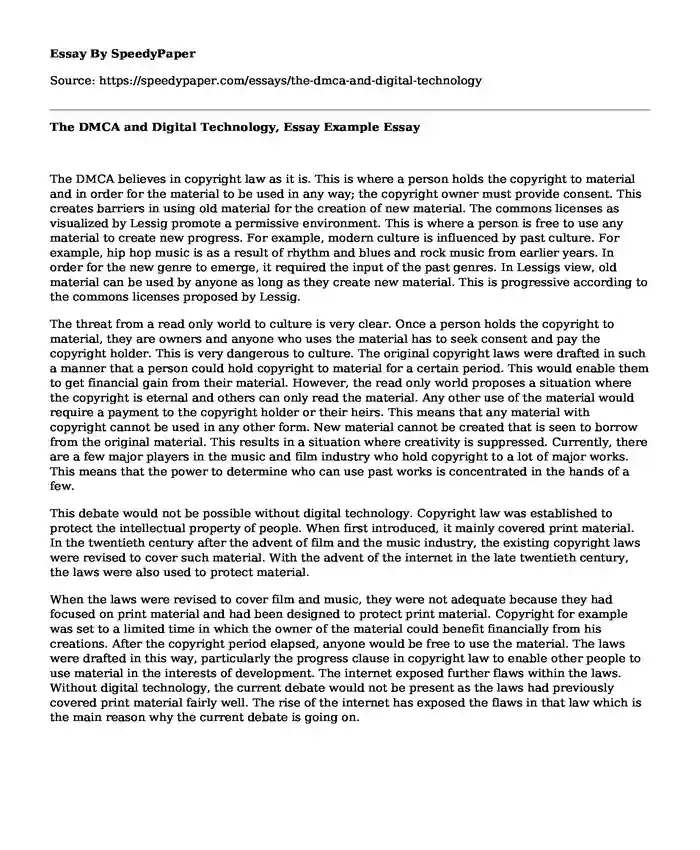
| Type of paper: | Essay |
| Categories: | Law Information technologies |
| Pages: | 3 |
| Wordcount: | 553 words |
The DMCA believes in copyright law as it is. This is where a person holds the copyright to material and in order for the material to be used in any way; the copyright owner must provide consent. This creates barriers in using old material for the creation of new material. The commons licenses as visualized by Lessig promote a permissive environment. This is where a person is free to use any material to create new progress. For example, modern culture is influenced by past culture. For example, hip hop music is as a result of rhythm and blues and rock music from earlier years. In order for the new genre to emerge, it required the input of the past genres. In Lessigs view, old material can be used by anyone as long as they create new material. This is progressive according to the commons licenses proposed by Lessig.
The threat from a read only world to culture is very clear. Once a person holds the copyright to material, they are owners and anyone who uses the material has to seek consent and pay the copyright holder. This is very dangerous to culture. The original copyright laws were drafted in such a manner that a person could hold copyright to material for a certain period. This would enable them to get financial gain from their material. However, the read only world proposes a situation where the copyright is eternal and others can only read the material. Any other use of the material would require a payment to the copyright holder or their heirs. This means that any material with copyright cannot be used in any other form. New material cannot be created that is seen to borrow from the original material. This results in a situation where creativity is suppressed. Currently, there are a few major players in the music and film industry who hold copyright to a lot of major works. This means that the power to determine who can use past works is concentrated in the hands of a few.
This debate would not be possible without digital technology. Copyright law was established to protect the intellectual property of people. When first introduced, it mainly covered print material. In the twentieth century after the advent of film and the music industry, the existing copyright laws were revised to cover such material. With the advent of the internet in the late twentieth century, the laws were also used to protect material.
When the laws were revised to cover film and music, they were not adequate because they had focused on print material and had been designed to protect print material. Copyright for example was set to a limited time in which the owner of the material could benefit financially from his creations. After the copyright period elapsed, anyone would be free to use the material. The laws were drafted in this way, particularly the progress clause in copyright law to enable other people to use material in the interests of development. The internet exposed further flaws within the laws. Without digital technology, the current debate would not be present as the laws had previously covered print material fairly well. The rise of the internet has exposed the flaws in that law which is the main reason why the current debate is going on.
Cite this page
The DMCA and Digital Technology, Essay Example. (2019, Jul 19). Retrieved from https://speedypaper.net/essays/the-dmca-and-digital-technology
Request Removal
If you are the original author of this essay and no longer wish to have it published on the SpeedyPaper website, please click below to request its removal:
- Body Language Essay Sample
- Essay Sample on the Community Housing Project
- Free Essay: Funding Opportunities Announcements and Requests for Proposals
- Forensic Accountant Essay Example
- The Application of Ethical Theories Free Essay
- Identification and Discussion of Major Dilemmas. Paper Example
- Essay Sample on Impact of the Foreign Waste Ban
Popular categories




